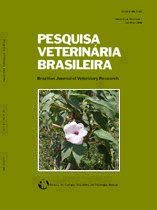 |
|
|
|
Year 2012 - Volume 32, Number 1
|

|
Comparison of anterior ocular segment structures in healthy dogs, with diabetic or no diabetic cataract, by ultrasound biomicroscopy, 32(1):66-71
|
ABSTRACT.- Galego M.P., Safatle A.M.V., Otsuki D., Hvenegaard A.P., Castanheira V.R. & Barros P.S.M. 2012. [Comparison of anterior ocular segment structures in healthy dogs, with diabetic or no diabetic cataract, by ultrasound biomicroscopy.] Estudo comparativo das estruturas do segmento anterior de olhos de cães normais e com catarata, portadores ou não de Diabetes mellitus, avaliados por biomicroscopia ultrassônica. Pesquisa Veterinária Brasileira 32(1):66-71. Departamento de Cirurgia, Faculdade de Zootecnia e Medicina Veterinária, Universidade de São Paulo, Av. Prof. Dr. Orlando de Marques de Paiva 87, Bloco 8 superior, Cidade Universitária, São Paulo, SP 05508-270, Brazil. E-mail: mpgalego@uol.com.br
Cataracts represent the leading cause of blindness in dogs. The second most common cause of cataract in dogs is a result of metabolic alterations caused by Diabetes mellitus (DM). Ultrasound biomicroscopy (UBM) is a high-frequency (50 MHz) ultrasonographic method that produces B mode images of microscopic quality. The objective of this study was, by means of UBM use, to compare the anterior segment structures of the canine eyes, both with diabetic and non-diabetic cataract, in order to detect changes caused by DM. The parameters evaluated were: cornea thickness, anterior chamber’s depth, increased cellularity inside the anterior chamber, and iridocorneal angle measurement. Eighty-seven eyes of 47 dogs were examined, divided into three groups: control (GCO), non-diabetic cataract (GCAT) and diabetic cataract (GDM). The results showed that the diabetic group presented a higher cornea thickness than the other groups. The control group showed deeper anterior chambers without increased cellularity. When the iridocorneal angle measurements were analyzed, it was found that there were no statistically significant differences between the three groups. Based on these results, we can conclude that: the eyes of diabetic dogs with cataract showed a central cornea higher thickness compared to the eyes of dogs with cataract of different etiologies, and to dogs with normal eyes; there is a decrease of the anterior chamber depth and a increase of cellularity in the eyes of dogs with cataract compared to normal eyes, there is no significant difference between the iridocorneal angle measurement in the eyes of dogs with cataract, diabetic or not, and normal dogs. |
| |
|
|
| |
|
 |